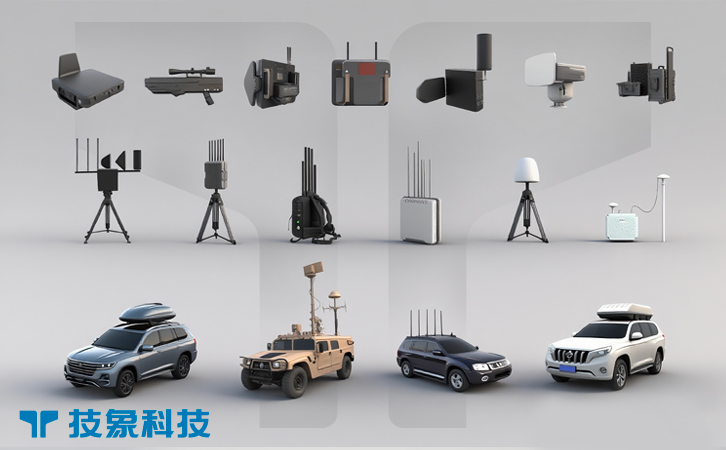The rapid proliferation of unmanned aerial vehicles (UAVs) has necessitated the development and deployment of anti-UAV systems to counter threats ranging from unauthorized surveillance to potential terrorist attacks. However, deploying these systems, which often involve technologies like radiofrequency (RF) jamming, lasers, or physical interception, is heavily influenced by global regulatory frameworks. These regulations vary across jurisdictions, reflecting differences in airspace management, privacy concerns, and public safety priorities. Navigating this complex legal landscape is critical for ensuring the lawful and effective use of anti-UAV systems in military, civilian, and commercial contexts. This article examines the global regulatory frameworks governing anti-UAV system deployment, detailing key restrictions, international coordination efforts, regional variations, and emerging trends.
I. Regulatory Constraints on Anti-UAV Technologies
Anti-UAV systems employ a range of technologies, such as RF jamming, high-powered lasers, and net-based capture, each subject to specific regulatory constraints. RF jamming, which disrupts drone communication or GPS signals, is heavily restricted in many countries due to its potential to interfere with legitimate communications, such as emergency services, aviation systems, or public Wi-Fi networks. For example, in the United States, the Federal Communications Commission (FCC) prohibits unauthorized RF jamming under the Communications Act of 1934, limiting its use to federal agencies like the Department of Defense or Department of Homeland Security in specific scenarios, such as protecting military bases or critical infrastructure.
Kinetic countermeasures, like lasers or projectiles, face regulations related to safety and environmental impact. High-powered lasers, such as those used in systems like Raytheon’s HELWS, must comply with international standards set by organizations like the International Civil Aviation Organization (ICAO), which regulates laser emissions near airports to prevent interference with aircraft operations. Physical interception methods, such as net-launchers, are less restricted but must adhere to safety protocols to avoid collateral damage, particularly in urban areas. Data collection by anti-UAV systems, such as EO/IR cameras or RF sensors, raises privacy concerns, requiring compliance with data protection laws like the European Union’s General Data Protection Regulation (GDPR). These constraints necessitate careful system design and deployment strategies to align with legal requirements while maintaining effectiveness.
II. International Coordination and Standardization Efforts
The global nature of drone threats, particularly in cross-border scenarios, underscores the need for international coordination in regulating anti-UAV systems. Organizations like the ICAO and the International Telecommunication Union (ITU) play key roles in developing guidelines for airspace security and spectrum management. The ICAO’s Unmanned Aircraft Systems (UAS) framework encourages member states to harmonize anti-UAV regulations to ensure safe integration of drones and countermeasures into global airspace. For instance, ICAO’s guidelines emphasize the need for clear rules on countermeasure deployment near airports to prevent disruptions to manned aviation, as seen in the 2018 Gatwick Airport drone incident.
The ITU regulates RF spectrum usage, critical for anti-UAV systems that rely on jamming or signal detection. It allocates specific frequency bands for drone communications and sets limits on interference, requiring anti-UAV systems to operate within designated parameters. International agreements, such as the Wassenaar Arrangement, control the export of dual-use technologies like high-powered lasers, impacting the global availability of advanced anti-UAV systems. Collaborative efforts, like NATO’s Counter-UAS initiatives, promote interoperability among member states, standardizing detection protocols and countermeasure technologies for joint military operations. These efforts aim to create a cohesive global framework, but challenges remain due to differing national priorities and legal systems, necessitating ongoing diplomatic coordination.
III. Regional Variations in Anti-UAV Regulations
Regulatory frameworks for anti-UAV systems vary significantly across regions, reflecting local security needs, legal traditions, and technological adoption. In the United States, the Federal Aviation Administration (FAA) oversees airspace security, granting limited authority to federal agencies for anti-UAV deployment while restricting civilian use of jammers due to FCC regulations. The FAA’s Remote ID rule, implemented in 2023, mandates that drones broadcast identification signals, aiding anti-UAV systems in distinguishing authorized from unauthorized UAVs, but countermeasure deployment remains tightly controlled.
In the European Union, anti-UAV regulations are shaped by GDPR and aviation safety laws enforced by the European Union Aviation Safety Agency (EASA). EU member states, like Germany and France, permit limited use of anti-UAV systems for critical infrastructure protection but require strict oversight to ensure privacy and safety. For example, France deployed anti-UAV jammers during the 2024 Paris Olympics, but only under government authorization. In contrast, countries like China and Russia have more permissive frameworks for military and state-led deployments, with fewer restrictions on jamming or kinetic countermeasures, reflecting centralized control over airspace. In developing nations, such as those in Africa or Southeast Asia, regulatory frameworks are often nascent, leading to inconsistent enforcement and reliance on imported systems, which complicates compliance with international standards. These regional differences create a patchwork of regulations, challenging global operators and manufacturers.
IV. Emerging Trends and Regulatory Evolution
As drone technology evolves, so too must the regulatory frameworks governing anti-UAV systems. Emerging trends include the integration of AI-driven anti-UAV systems, which require new guidelines for autonomous decision-making to ensure accountability. For instance, AI systems that automatically neutralize drones must comply with ethical standards to avoid excessive force or unintended consequences. The rise of drone swarms has prompted regulators to consider rules for wide-area countermeasures, such as high-powered microwave (HPM) systems, which could disrupt broader communication networks if not tightly controlled.
Another trend is the push for real-time data sharing and interoperability. Regulatory bodies are exploring frameworks for integrating anti-UAV systems with air traffic management networks, enabling seamless coordination across jurisdictions. For example, the FAA’s Low Altitude Authorization and Notification Capability (LAANC) system could be expanded to include anti-UAV data feeds. Privacy regulations are also evolving, with increased scrutiny on how anti-UAV systems handle data collected during operations. The EU is leading efforts to develop “privacy-by-design” standards for anti-UAV systems, requiring manufacturers to embed data protection features. Additionally, international forums are advocating for standardized licensing for anti-UAV operators, similar to pilot certifications, to ensure consistent training and accountability. These trends signal a shift toward more adaptive, globally aligned regulations that balance innovation with safety and privacy.
Conclusion
Global regulatory frameworks for anti-UAV system deployment are complex and varied, shaped by technical, safety, and ethical considerations. Constraints on technologies like RF jamming and lasers, combined with international coordination efforts and regional variations, create a challenging landscape for developers and operators. Emerging trends, such as AI integration and data-sharing protocols, are driving regulatory evolution to address new threats like drone swarms while ensuring compliance with privacy and safety standards. As drone usage continues to grow, harmonizing these frameworks will be critical to enable effective, lawful, and ethical anti-UAV deployments, ensuring secure airspace for military, civilian, and commercial applications worldwide.



